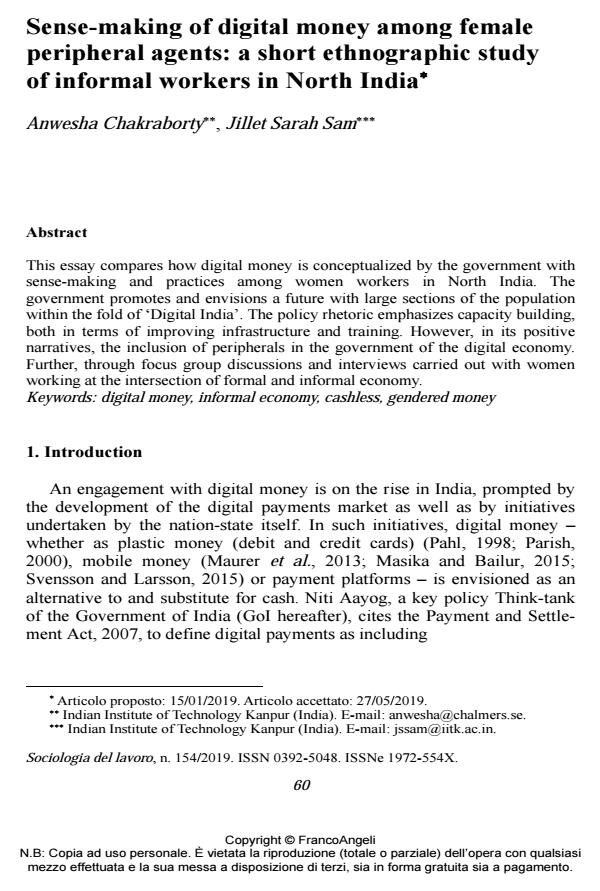Sense-making of digital money among female peripheral agents: a short ethnographic study of informal workers in North India
Journal title SOCIOLOGIA DEL LAVORO
Author/s Anwesha Chakraborty, Jillet Sarah Sam
Publishing Year 2019 Issue 2019/154
Language English Pages 19 P. 60-78 File size 197 KB
DOI 10.3280/SL2019-154004
DOI is like a bar code for intellectual property: to have more infomation
click here
Below, you can see the article first page
If you want to buy this article in PDF format, you can do it, following the instructions to buy download credits

FrancoAngeli is member of Publishers International Linking Association, Inc (PILA), a not-for-profit association which run the CrossRef service enabling links to and from online scholarly content.
This essay compares how digital money is conceptualized by the government with sense-making and practices among women workers in North India. The government promotes and envisions a future with large sections of the population within the fold of ‘Digital India’. The policy rhetoric emphasizes capacity building, both in terms of improving infrastructure and training. However, in its positive narratives, the inclusion of peripherals in the government of the digital economy. Further, through focus group discussions and interviews carried out with women working at the intersection of formal and informal economy.
Keywords: Digital money, informal economy, cashless, gendered money
- Bathija M. (2018). Internet Saathi: Improving Digital Literacy among Women. Forbes India. -- Text available at the website: www.forbesindia.com/article/future-of-work/internet-saathi-improving-digital-literacy-among-women/50951/1. Accessed January 13, 2019.
- Bhatia P. (2017). Story behind Surge in UPI Transactions and What Can Make It Truly Transformational. Economic Times. -- Text available at the website: -- https://economictimes.indiatimes.com/small-biz/startups/features/story-behind-surge-in-upi-transactions-and-what-can-make-it-truly-transformational/articleshow/62075406.cms. Accessed January 13, 2019.
- Carruthers B.G., Espeland W.N. (1998). Money, Meaning, and Morality. American Behavioral Scientist, 41(10): 1384-1408. DOI: 10.1177/0002764298041010003
- Committee of Chief Ministers (2017). Interim Report of the Committee of Chief Ministers on #Digital Payments. New Delhi: Niti Aayog. -- Text available at the website: https://niti.gov.in/writereaddata/files/new_initiatives/DigiReport-FInal.pdf. Accessed January 13, 2019.
- Dodd N. (2014). The Social Life of Money. Princeton, NJ: Princeton University Press.
- Doron A. (2012). Mobile Persons: Cell Phones, Gender and the Self in North India. The Asia Pacific Journal of Anthropology, 13(5): 414-433. DOI: 10.1080/14442213.2012.726253
- Doron A., Jeffrey R. (2013). The Great Indian Phone Book: How the Cheap Cell Phone Changes Business, Politics, and Daily Life. Cambridge, Massachusetts: Harvard University Press.
- Hart K. (1985). Informal Economy. The Cambridge Journal of Anthropology, 10(2): 54-58.
- Kaka N., Madgavkar A., Manyika J., Bughin J., Parameswaran P. (2014). India’s Technology Opportunity: Transforming Work, Empowering People. India: McKinsey Global Institute. -- Text available at the website: www.mckinsey.com/~/media/McKinsey/Industries/High%20Tech/Our%20Insights/Indias%20tech%20opportunity%20Transforming%20work%20empowering%20people/MGI%20India%20tech_Full%20report_December%202014.ashx.
- Kini S. (2018). She Is Offline: India’s Digital Gender Divide. Live Mint. -- Text available at the website: www.livemint.com/Opinion/sD6mVqLAEa7cvfJtmdXXuO/She-is-offlineIndias-digital-gender-divide.html. Accessed January 13, 2019.
- Masika R., Bailur S. (2015). Negotiating Women’s Agency through ICTs: A Comparative Study of Uganda and India. Gender, Technology and Development, 19(1): 43-69. DOI: 10.1177/0971852414561615
- Maurer B., Taylor N., Rea S. (2013). ‘Bridges to Cash’: Channelling Agency in Mobile Money. Journal of the Royal Anthropological Institute, 19(1): 52-74. DOI: 10.1111/1467-9655.12003
- Niti Aayog (2018). Digital Money: Trends, Issues and Opportunities. New Delhi: Department of Economic Affairs, Ministry of Finance, Government of India. -- Text available at the website: https://niti.gov.in/writereaddata/files/document_publication/DigitalPaymentBook.pdf. Accessed January 13, 2019.
- Pahl J. (1999). Social Polarization in the Electronic Economy. The Sociological Review, 47(2): 87-106.
- Parish J. (2000). From the Body to the Wallet: Conceptualizing Akan Witchcraft at Home and Abroad. Journal of the Royal Anthropological Institute, 6(3): 487-500. DOI: 10.1111/1467-9655.00028
- Portes A., Castells M. (1989). World underneath: The Origins, Dynamics, and Effects of the Informal Economy. In: Benton L., Portes A., Castells M., eds., The Informal Economy: Studies in Advanced and Less Developed Countries. Baltimore: Johns Hopkins University Press.
- Portes A., Haller W. (2010). The Informal Economy. In: Smelser N.J., Swedberg R., eds., The Handbook of Economic Sociology. Princeton: Princeton University Press.
- Singh S. (1997). Marriage Money: The Social Shaping of Money in Marriage and Banking. St. Leonards, N.S.W: Allen & Unwin.
- Singh S. (1998). Understanding the Use of Electronic Money: The Missing Factor in Policy. Melbourne, Australia: CIRCIT, RMIT and Center for Information Policy Research, Harvard University.
- Singh S. (2013). Globalization and Money: A Global South Perspective. Lanham, Maryland: Rowman and Littlefield.
- Singh S. (2016). Money, Migration and Family: India to Australia. New York: Nature America Inc.
- Sood N. (2017). Locating Gender in Digital India: Generating Feminist Liberation or Patriarchal Control. Master’s Thesis, Helsinki: University of Helsinki. -- Text available at the website: https://helda.helsinki.fi/bitstream/handle/10138/229576/Sood_PoliticalScience.pdf?sequence=2&isAllowed=y. Accessed January 13, 2019.
- Subramanian S. (2008). Control and Access: The Everyday Dimensions of Property. Contributions to Indian Sociology, 42(1): 93-122. DOI: 10.1177/006996670704200105
- Svensson J., Larsson CW. (2016). Situated Empowerment: Mobile Phones Practices among Market Women in Kampala. Mobile Media and Communication, 4(2): 205-220. DOI: 10.1177/2050157915619212
- Vosloo S. (2018). Designing Inclusive Digital Solutions and Developing Digital Skills: Guidelines. Paris: United Nations Educational, Scientific and Cultural Organization Digital Library. -- Text available at the website: https://unesdoc.unesco.org/ark:/48223/pf0000265537. Accessed January 13, 2019.
- Zelizer V.A. (1989). The Social Meaning of Money: ‘Special Monies’. American Journal of Sociology, 95(2): 342-377.
- Zelizer V.A. (2017). The Social Meaning of Money: Pin Money, Paychecks, Poor Relief & Other Currencies. Princeton, NJ: Princeton University Press.
- Addressing corruption through visual tools in India: the case of three civil society initiatives and their Facebook pages Anwesha Chakraborty, Alice Mattoni, in Visual Studies /2023 pp.803
DOI: 10.1080/1472586X.2023.2239759 - Improving Transparency in Service Delivery to Fight Corruption? Mapping Multi-Stakeholder Voices on Digitization in the Indian Public Healthcare Sector Anwesha Chakraborty, Ina Kubbe, in American Behavioral Scientist 00027642241268555/2024
DOI: 10.1177/00027642241268555 - Off-platform Social Networks and Gig Work During the COVID-19 Pandemic in India Rajorshi Ray, Jillet Sarah Sam, in Journal of South Asian Development /2023 pp.359
DOI: 10.1177/09731741231191876
Anwesha Chakraborty, Jillet Sarah Sam, Sense-making of digital money among female peripheral agents: a short ethnographic study of informal workers in North India in "SOCIOLOGIA DEL LAVORO " 154/2019, pp 60-78, DOI: 10.3280/SL2019-154004